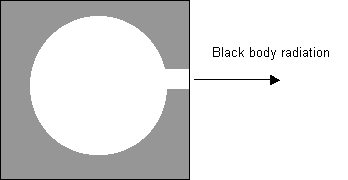Radiation
In
this module we have been concerned with how to detect stellar objects.
To detect them we have to detect radiation emitted from them.
We are now going to consider an idealised “model” for the emission of
radiation. By “radiation” we mean any form of e/m radiation: Gamma through to Radio – including visible
light.
Black body
radiation
Q:
what is a better emitter of radiation – matt black surfaces or polished
reflectors? - matt black: any body that maintains a constant temperature will be
emitting radiation at the same rate as it is absorbing it.
Matt
black is both a good absorber and a good emitter
Polished
silver is a poor absorber and a poor emitter.
No
surface is a 100% perfect absorber/emitter.
The IDEAL model is a “black body” – a perfect absorber and emitter.
The radiation it would emit is called BLACK BODY RADIATION.
This
is a useful mathematical construction – it allows us to ignore surface
properties of the radiator. It’s
use is akin to the IDEAL GAS. Neither
exist – but they allow us to do the maths.
Experimentally
a black body can be improvised by taking a hollow ball – coating the walls
with soot and then drilling a hole in it. If
we warm this object – the radiation it emits will simulate perfect black body
radiation.
|
|
|
|
|
|
Quick
practical:
1. Observe the colour
changes when running a filament lamp at different temperatures.
All
wavelengths = 3000K
. Red
colour = 1200K
2.
Heat nichrome wire in a Bunsen burner –
observe the colour changes.
|
|
|
 |
|
See
diagram P.18 – McGilivray - note
that the peaks are displaced to shorter wavelenghts with an increase in
temperature. As T is increased the
intensity of each wavelength increases, but shorter wavelengths show the most
marked increase.
Note:
l
max = approx: 3000nm for 1000K temp
l maxT = approx = 0.003 m K
And:
l max = approx: 2000nm for 1400K temp
l maxT = approx = 0.0028 m K
This leads to
Wein’s displacement law:
Wien’s
constant
| l
maxT
= constant
= 0.0029 m K
|
 |
Wien’s constant |
This
can be used to estimate the temperature of a star or other stellar objects (-
“sources”)
Estimating the
Temperature of a Star
Stars approximate to black body
radiators. The wavelength that
corresponds to the peak power output provides an approx method of
determining it’s effective surface temperature.
Eg:
The peak wavelength of the sun is 490 nm – estimate it’s effective
surface temp:
Teff
= 0.0029 / 490 x10-9
= 5920 K – what’s that
in degrees? 5920 - 273
= 5647oC
Note:
1.
assume it’s a perfect black body
2.
there is considerable variation in temp throughout the layers of a star.
The corona of the sun has a temp of 106 K while the temp at
the core is 1.4 x 107 K. Calculate
the peak wavelength for these two.
Colour of
stars:
Our sun is yellow cos the peak
wavelength – 490 nm - blue/
green region combines with the longer wavelengths from yellow, orange and red
parts to produce the overall yellow effect.
Estimate
these temps: Betelgeuse in the
constellation of Orion is a Red Giant , Sirius – the brightest star in the sky
is blue in colour.
Wein says that the total energy
emitted per second increases with increasing temperature.
Increased area also increases the total energy per second emitted.
The link between radiated power and temperature was investigated by
Stefan in1884.
Stefan’s
law: P
= s
A
T4
P
= radiated power
A
= surface area
T
= surface temperature
s
= Stefan's constant = 5.7 x 10-8 W m-2 K-4
Example:
Estimate
the surface temperature of the sun if has a radius of 6.96 x 108 m
and it emits radiation at a power of 4.5 x 1026 Watts
--> T = 4th root of (P/
s
4
p R2)
--> 6010 K
NB
not the same as Wein’s result …
assumptions based on the sun being a perfect black body.
Q
Estimate the area needed for a source at 4000K to have the same power
output as the sun:
Take
Tsun = 6000K
Tsun4
Asun = Tsource4Asource
Q
Estimate the power radiated from the surface of the earth.
Take the average surface temperature of the earth to be 17oC
Q
9.12 & 9.13 from Breithaupt
Check
out:
